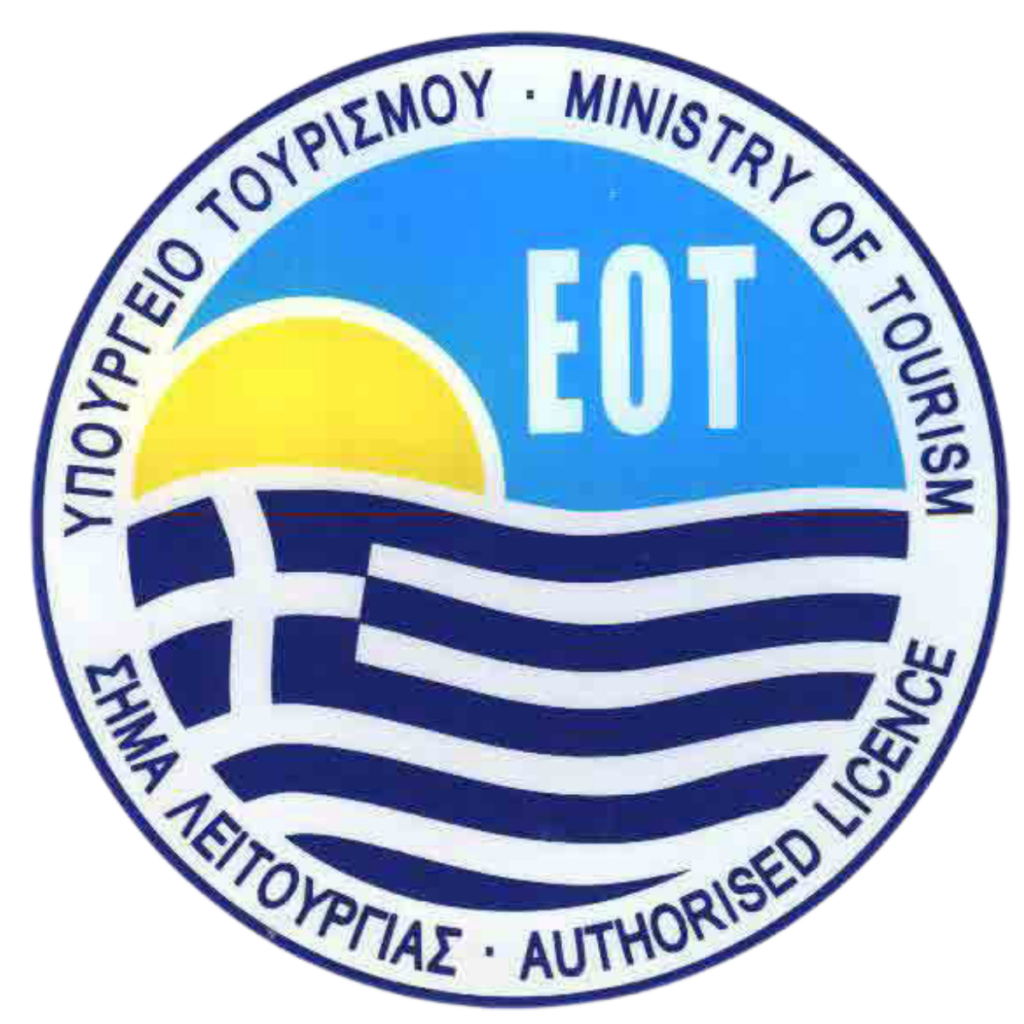Tour itinerary
4-5 hours roundtrip | 4 places | 1 stop for lunch
Start our tour from Athens
We begin our tour early in the morning from Athens. Our driver will collect you from your hotel, apartment, or the airport/port.
Corinth Canal
The Corinth Canal links the Gulf of Corinth in the Ionian Sea with the Saronic Gulf in the Aegean Sea. It cuts across the narrow Isthmus of Corinth, effectively separating the Peloponnese from the Greek mainland and arguably turning the peninsula into an island. The canal, which is 6.4 kilometers (4 miles) long and 21.4 meters (70 feet) wide at its base, has no locks and is dug at sea level, making it too narrow for many modern ships. From a high vantage point, you can enjoy a spectacular view of the isthmus and admire the steep limestone walls while watching the vessels navigate through the canal below.
Mycenae
The fortified citadel of ancient Mycenae was the seat of the legendary King Agamemnon. This impressive and well-preserved site lent its name to an entire civilization. Here, you can admire landmarks such as the Tomb of Clytemnestra, the famous Lion’s Gate, and the Cyclopean walls while learning about their bloody history. In the second millennium BC, Mycenae was a major center of Greek civilization and a military stronghold that controlled much of southern Greece, Crete, the Cyclades, and parts of southwest Anatolia. The era of Greek history from around 1600 BC to about 1100 BC is named the Mycenaean period after Mycenae. At its height in 1350 BC, the citadel and its surrounding town had a population of 30,000 and covered an area of 32 hectares.
Archaeological site of Mycenae
The archaeological site of Mycenae includes the fortified acropolis and the surrounding funerary and habitation areas, primarily situated to its west and southwest. Most of the visible structures date back to the site’s peak period from 1350 to 1200 BC. The nearly triangular acropolis is enclosed by massive Cyclopean walls and is accessed from the northwest through the renowned Lion Gate. This gate, named for the two opposing lions carved in relief within the relieving triangle above the door, symbolizes the power of the Mycenaean rulers and is a distinctive element of Mycenaean architecture.
Lion Gate
The Lion Gate was the primary entrance to the Bronze Age citadel of Mycenae in southern Greece. Built around 1250 BC on the northwest side of the acropolis, it is named for the relief sculpture of two lionesses or lions in a heraldic pose above the entrance. The Lion Gate is the only surviving monumental piece of Mycenaean sculpture and the largest sculpture from the prehistoric Aegean. It is the sole monument from Bronze Age Greece that features an iconographic motif which remained above ground and was described in classical antiquity literature, making it well known even before the advent of modern archaeology.
Archaeological Museum of Mycenae
The Archaeological Museum of Mycenae is located at the entrance of the ancient site, just a short distance from the Lion Gate.
Treasury of Atreus
The Treasury of Atreus, also known as the Tomb of Agamemnon, is a large beehive tomb located on Panagitsa Hill in Mycenae, built around 1250 BC during the Bronze Age. The stone lintel above the doorway, weighing 120 tons and measuring approximately 8.3 x 5.2 x 1.2 meters, is the largest in the world. The tomb was in use for an unknown duration. It was mentioned by the Roman geographer Pausanias in the 2nd century AD and was still visible in 1879 when German archaeologist Heinrich Schliemann discovered the shaft graves beneath the “agora” in the Acropolis at Mycenae.
Archaeological Museum of Epidaurus
The Archaeological Museum of Epidaurus is located in Epidaurus, Argolis, on the Peloponnese peninsula in Greece. Established in 1902 and opened in 1909, the museum is renowned for its reconstructions of temples, as well as its collection of columns and inscriptions. It showcases artifacts excavated from the ancient site of Epidaurus and its surrounding area.
Ancient Theatre of Epidaurus
The Ancient Theatre of Epidaurus is located in the Greek city of Epidaurus, at the southeast end of the sanctuary dedicated to Asclepius, the ancient Greek god of medicine. Situated on the west side of Cynortion Mountain near modern Lygourio, it is part of the Epidaurus Municipality. Renowned for its exceptional acoustics and aesthetics, it is considered the most perfect ancient Greek theatre. The theatre preserves the characteristic tripartite structure of a Hellenistic theatre, consisting of a theatron, orchestra, and skene. Notably, it remained unaltered during Roman times, unlike many other Greek theatres.
Temple of Asclepius
The Temple of Asclepius was a sacred sanctuary in Epidaurus devoted to the worship of Asclepius, serving as the primary holy site dedicated to the deity. This sanctuary in Epidaurus rivaled major cult sites such as the Sanctuary of Zeus at Olympia and Apollo at Delphi. Constructed in the early 4th century BC, if the temple was still in operation by the 4th century AD, it would likely have been shut down during the persecution of pagans in the late Roman Empire. During this period, Christian Emperors issued edicts forbidding non-Christian worship.
Nafplio
Enjoy some free time for lunch, coffee, or shopping in Nafplio, often referred to as the ‘Naples of the East’, renowned for its Venetian architecture, charming cobbled squares, and majestic castles offering panoramic views of the Argolic Gulf. Afterwards, take a leisurely stroll by the harbor or wander through the vibrant backstreets of this sophisticated town, considered one of the most elegant on the Greek mainland. Nafplio, situated on the Peloponnese peninsula, has expanded up the hillsides near the northern end of the Argolic Gulf. Throughout history, it served as a significant seaport under various ruling houses during the Middle Ages, initially under the de la Roche family following the Fourth Crusade, then under the Republic of Venice, and later under the Ottoman Empire. During the Greek Revolution in 1821, Nafplio became the capital of the First Hellenic Republic and subsequently the Kingdom of Greece until 1834. Today, Nafplio serves as the capital of the Argolis regional unit.
Bourtzi
Take in the captivating sight of the Bourtzi water castle, a Venetian fortress nestled in the heart of Nafplio’s harbor. Capture stunning photographs from the harbor side, capturing the castle’s timeless allure against the backdrop of the sparkling waters.
Acronauplia
The Acronauplia stands as the oldest district within Nafplion, Greece, having existed as an independent town until the thirteenth century. With the arrival of the Venetians and Franks, it became integrated into the town’s fortifications. Over time, sections of it were repurposed, serving as a prison until the Greek government recognized its potential to enhance local tourism. Subsequently, a hotel complex was constructed on the site, which remains a prominent feature to this day, offering visitors stunning views of the surrounding area.
Palamidi Fortress
Palamidi is a fortress located to the east of the Acronauplia in the town of Nafplio, situated in the Peloponnese region of southern Greece. Perched atop a 216-meter high hill, this fortress was constructed by the Venetians during their second occupation of the area from 1686 to 1715. Offering commanding views over the Argolic Gulf, the city of Nafplio, and the surrounding countryside, Palamidi is a remarkable sight to behold. Access to the fortress is facilitated by a winding stairway consisting of 913 steps from the town. However, to reach the summit, there are over one thousand steps, although local lore in Nafplion often asserts there are precisely 999 steps leading to the top of the castle.






